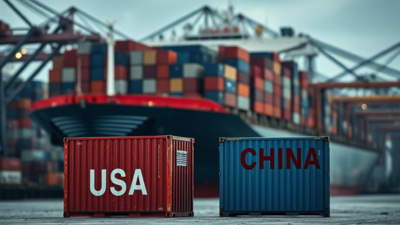US-China trade war escalates with new round of tit for tat tariffs, timeline from Trump’s first term

The trade war between the United States and China continues to intensify, with both countries ramping up tariffs and retaliatory actions. On April 4, 2025, China announced a series of countermeasures in response to President Donald Trump‘s imposition of 34% tariffs on all Chinese imports, according to AP.
These measures include additional export controls on rare earth minerals, a lawsuit at the World Trade Organization (WTO), suspensions of US agricultural imports such as sorghum and poultry, and new restrictions on US companies.
This rapid escalation is reminiscent of the intense tariff battles during Trump’s first term in office, with both nations engaging in tit-for-tat retaliatory measures that have hurt each other’s economies. While China’s latest actions are designed to challenge the impact of US tariffs, they also threaten to exacerbate the trade imbalance and place further strain on global supply chains.
Key moments in the US-China trade spat:
March 2017:
Shortly after taking office, Trump signs an executive order calling for tighter tariff enforcement in anti-dumping cases to reduce trade deficits.
April 2017:
Trump and Chinese President Xi Jinping agree to a 100-day trade plan, but the talks collapse by July.
August 2017
Trump launches an investigation into alleged Chinese theft of US intellectual property, with an estimated cost to the US of up to $600 billion annually.
January 2018
The US announces 30% tariffs on imported solar panels, predominantly from China.
April 2018
China retaliates with tariffs on US goods worth $3 billion, including fruits, nuts, wine, and pork, and escalates by imposing 25% tariffs on additional US goods worth about $50 billion. The US follows with 25% tariffs on aerospace, machinery, and medical products from China.
June-August 2018
Both nations impose multiple rounds of tariffs, affecting over $350 billion in Chinese goods and $110 billion in US products, including a 10% tariff on $200 billion worth of Chinese imports in September 2018, which was set to rise to 25% by January 2019.
December 2018-May 2019:
Negotiations to finalize a trade deal fail, and the US increases tariffs on $200 billion worth of Chinese goods from 10% to 25%.
May 2019:
The US bans Chinese tech giant Huawei from purchasing US components, worsening relations.
June 2019:
Trump and Xi agree to restart trade talks, but progress is slow, with continued disagreements over tariffs.
January 2020:
The US and China sign the Phase One trade deal, which includes China’s promise to purchase an additional $200 billion of US goods. However, a later report reveals China largely failed to meet those commitments.
October 2022:
President Biden retains most of the tariffs imposed under Trump and implements sweeping restrictions on semiconductor exports to China.
February 2024:
Trump, on the campaign trail, promises to impose a 60% tariff on all Chinese imports if re-elected.
May 2024:
Biden increases tariffs on Chinese electric vehicles, solar cells, steel, aluminum, and medical equipment.
February 2025:
A new round of 10% tariffs on all Chinese imports is introduced by the US, with China retaliating by imposing similar tariffs on US coal, liquefied natural gas, and agricultural machinery.
March 2025:
An additional 10% tariff on all Chinese goods is set to take effect, prompting China to counter with up to 15% tariffs on key US farm products, including soybeans, pork, chicken, and beef, alongside expanded restrictions on US companies.
April 3 2025:
In what is being called Trump’s “Tariff Liberation Day,” the US announces a new 34% tariff on all Chinese imports, prompting China to take further action with new export controls.
April 4, 2025
China announces other retaliatory moves including more export controls on rare earth minerals, and files a lawsuit at the World Trade Organisation. China also suspends imports of sorghum, poultry and bonemeal from several US companies, adds 27 firms to lists of companies facing trade restrictions, and starts an anti-monopoly probe into DuPont China Group Co.




